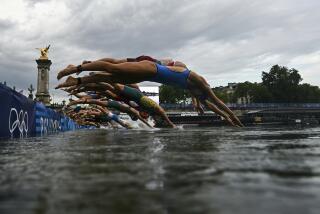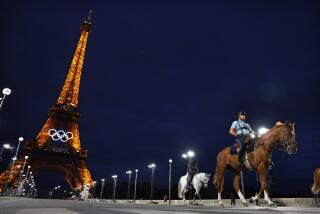A Bridge Too Plain: Parisians Criticize Uninspiring New Span
- Share via
PARIS — City officials promised a “bridge to the 21st century,” a state-of-the-art Seine River crossing that would ease the capital’s choking traffic and open decayed eastern neighborhoods to development.
What they delivered was an over-budget $48-million span that has all the grace of an airplane wing and is widely ridiculed as “the bridge to nowhere.”
The Charles de Gaulle Bridge’s six car lanes and two sunken walkways run from a dingy neighborhood of empty offices on the Seine’s Right Bank to blocks of empty construction lots behind the Austerlitz train station on the Left.
“It’s a zero,” griped taxi driver Guillemet Delatouch. “It runs smack into the Austerlitz train station. They should have built it at a boulevard, but instead it’s useless, money thrown in the air.”
The government insists the site is a good one, arguing it will improve foot and car traffic between the two neighborhoods at either end as well as relieve congestion on one of the city’s busiest bridges down river.
But drivers say it isn’t a helpful route. Since the Charles de Gaulle opened in August, traffic tie-ups elsewhere haven’t improved. A visit during the afternoon rush hour one recent afternoon found the span only sparsely used by cars and empty for minutes at a time.
Like the 1980s’ Louvre pyramid, Grande Arche de la Defense office complex and Opera Bastille, the Charles de Gaulle Bridge imposes a modern touch on Paris’ landscape.
And like many of those “Great Projects” of the late Socialist President Francois Mitterrand, the bridge flouts practicality and thrift for the sake of architectural enterprise, its critics say.
Delatouch, the cabdriver, and others ask how the city spent so much on a project that was budgeted at one-tenth of what it cost.
The opposition Socialist Party has accused the conservative Paris government of former mayor and current President Jacques Chirac of covering up the bridge’s true cost. It also says the city’s 35 other Seine crossings made the Charles de Gaulle “one bridge too many.”
“This excessive and anachronistic project cost more than a billion francs [$200 million] to Paris taxpayers,” the party said.
But Paris public works official Jacques Monthioux, who was in charge of the construction, said the Socialists greatly exaggerate the cost. He says the government spent $48 million on the bridge itself and $102 million on renovations of stretches of river bank.
Perhaps the biggest problem was an unforeseen shift in the economy.
The bridge was started at a time when the city was planning ambitious development projects for the dilapidated neighborhoods on either end. But when the bottom dropped out of the Paris real estate market at the end of the 1980s, construction in those areas was canceled or suspended.
Chicago Mayor Richard Daley recently led a group of potential investors from the United States to look over the district at the bridge’s Left Bank end, but no deals were signed.
The bridge’s spare, modernistic design also has come in for criticism.
Even Monthioux offers only a tepid defense of its looks: “It’s not really architecturally exuberant. It has a modernism of form and a sobriety.”
With none of the majesty of the gilded Alexander III, nor the classical design of the aqueduct-like Pont Royal, the Charles de Gaulle lies far upriver from the swath of postcard Paris that follows the Seine from the Eiffel Tower past the Louvre Museum and Notre Dame Cathedral.
In a city considered one of the prettiest in the world, the Charles de Gaulle is unforgivably plain.
Its shining white aerodynamic underside resembles the Disneyland monorail, with twin supports shaped like inverted plastic egg baskets.
The winners of a 1986 design competition, architects Louis Arretche and Roman Karasinki, said they wanted to create a bridge of the 21st century--”a very thin object, a horizontal work without curb.”
“I prefer the other, older bridges,” said Florent Fournier, a 20-year-old student who was crossing the Charles de Gaulle for the first time. “But there’s a lot of room for pedestrians.”
More to Read
Sign up for Essential California
The most important California stories and recommendations in your inbox every morning.
You may occasionally receive promotional content from the Los Angeles Times.













